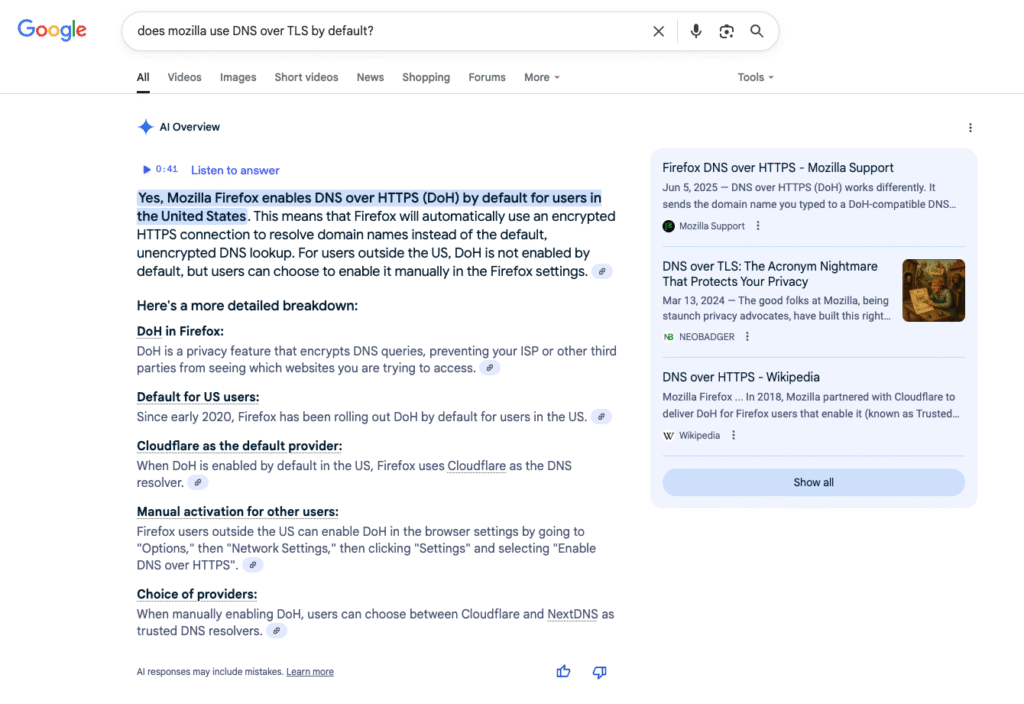The digital landscape, it’s a fickle thing, isn’t it? Just when you think you’ve got a handle on the search engine game, Google, or whoever, decides to pull the rug right out from under you. And right now, that rug is the AI Overview. It’s a shift, a seismic one really, in how folks consume information and, crucially, how they go about making decisions. This ain’t just some algorithmic tweak; it’s a fundamental recalibration of the internet’s central nervous system, and honestly, we’re all scrambling a bit, aren’t we?
For years, the unspoken rule of the internet was “click and explore”. You’d punch in a query, get a list of blue links, and then embark on a digital expedition, clicking from one site to another, piecing together your understanding. But with the AI Overview, we’re experiencing what the teabag is to the full-blown tea ceremony, miniature, handleless cups and all, for better or worse.
Now, you throw your query into a search engine, and poof, a concise, often surprisingly comprehensive answer appears right there, at the top of the results page. No burning needless calories clicking any links (and let’s be real, if you are anything like me, this constituted for at least 85% of your physical output). It’s immediate gratification, instant knowledge, and a radical departure from the content consumption habits we all just sort of, you know, adopted.

This immediacy fundamentally alters the value proposition of traditional website content. Think about it: if the answer is served up on a silver platter in the search results, why would anyone bother visiting your meticulously crafted blog post, your expertly curated product page, or your detailed and meticulously researched content? It’s a bit like a well-appointed restaurant serving up the entire meal on a sample stand at the front door, complete with delish Tassie apple pie dessert. Sure, it tastes good (even if you don’t really know what it went into making it or if it’s good for you), but nobody’s coming inside for the full experience, are they?
What’s even more intriguing, and perhaps a touch concerning, is the subtle yet pervasive shift in trust. There’s a growing body of anecdotal evidence, and increasingly, formal research, suggesting that users are beginning to trust these AI Overviews as much as, or even more than, the original content from which they were derived.
Dr. Oleg Zendel, a Research Fellow at RMIT University’s ARC Centre of Excellence for Automated Decision-Making and Society, notes that “the nature of the AI Overview means that the response will always sound right and provide related attributes, however, users need to evaluate those results and sources to check it’s factual.” This inherent “soundness,” that confident, almost authoritative tone, can subtly lull users into a false sense of security, leading them to accept the summary as gospel, perhaps without scrutinising the cited sources or seeking deeper context.

Indeed, a recent study revealed that while a significant majority of users (over 80%) expressed at least some skepticism towards AI Overviews, with 61.17% saying they “sometimes trust” them and 21.05% saying they “never trust” them, a surprisingly high number—over 40% across all age groups—rarely or never click through to the source material.
It’s a fascinating paradox, isn’t it?
People admit to a lack of full trust, yet they frequently forgo the very action that would allow them to verify or deepen their understanding. This suggests a form of “convenience over scrutiny” behaviour, where the ease of immediate answers outweighs the perceived need for critical engagement. This passive consumption, as Zendel highlights, can have a negative impact on search literacy, fostering a less critical approach to information.
The data confirms this unsettling trend. I’m seeing, in more and more cases, a fascinating mix of metrics: a noticeable drop in sessions, fewer pages viewed per session, and shorter session durations. Yet, interestingly enough, conversion rates for some businesses are actually increasing. This isn’t some digital paradox; it’s a clear indication that the “heavy lifting” of information gathering is now happening directly within the search engine context itself.
Users are arriving at your site already primed, pre-qualified, and often with a near-final decision in mind. It’s a double-edged sword, this. You get more serious buyers, but at what cost to the broader engagement and brand building that long-form content traditionally fostered? For instance, analysis by Amsive found that the average click-through rate (CTR) for queries triggering an AI Overview decreased by 15.49%, with non-branded searches seeing an even sharper drop of nearly 20%.
This “Great Decoupling” means that growth in impressions no longer necessarily translates to growth in clicks.
Publishers and Writers: The Uneasy Alliance with the Algorithm
For publishers and independent writers, the AI Overview presents an existential quandary. Their intellectual property, the very articles and insights they pour their time and talent into creating, are being “surfaced” within these generative AI platforms. The AI summarises, synthesises, and presents the information as its own, albeit often with links back to the original source. But those links, as the data suggests, are increasingly becoming mere footnotes rather than pathways to discovery.
It’s a bit like someone going to the effort of doing research for and then taking the time to write an article on AI Hallucinations or How Generative Technologies are Trained, or even SEO in an AI World, but all the advertising revenue goes to the search engine, not the writer. The content is consumed, the information disseminated, but the direct value, the traffic that underpins advertising models, subscriptions, and affiliate revenue, evaporates into the digital ether. This creates a deeply imbalanced ecosystem. Wait… this sounds familiar…
How do you compensate content creators for their valuable contributions when the primary point of consumption bypasses their established revenue streams? The Independent Publishers Alliance, for one, has actually filed a formal complaint with the European Commission, claiming market abuse. They aren’t wrong to be concerned; it feels like Google’s having its cake and eating yours too.
This phenomenon raises significant questions about intellectual property rights in the age of AI. Is the generative AI “transforming” the content enough to constitute a new creation, or is it merely re-packaging it in a way that devalues the original? It’s a legal and ethical quagmire, and honestly, the answer isn’t clear right now, which is a bit terrifying for anyone in the content game.
The argument often made by AI developers is that their models are “learning” from the vast corpus of internet data, much like a human learns by reading. However, when that “learning” directly substitutes the need to engage with the original source, the economic model for content creation begins to crumble.
E-commerce: From Curated Journeys to Comparative Checklists
E-commerce brands face a particularly pointed challenge. Many businesses invest significant resources in curating unique product collections, crafting compelling narratives around their offerings, and developing interactive tools like product customisers to enhance the shopping experience. They aim to guide customers through a journey, offering context, demonstrating value beyond just price, and building brand loyalty. However, the AI Overview tends to reduce this rich, multifaceted shopping experience into a comparative shopping engine.
When you search for “best teapots that keep tea hot longest”, the AI might instantly list a few top options, their prices, and perhaps a couple of key features, pulled from various retailers. The customer can then “shop” directly from within the search context, never needing to visit the e-commerce site that invested in detailed product descriptions, 360-degree views, customer reviews, or even a nuanced understanding of thermal regulation of a tea-holding receptacle.

This reductionist approach undervalues the extrinsic benefits of buying from a specific vendor. It strips away the consideration of superior customer support, expedited delivery times, robust after-sales protections, or even the ethical sourcing practices a brand might champion. All these differentiating factors, which take time and investment to build and communicate, become secondary to a quick, comparative price point.
What a shame, really. Businesses that have poured considerable resources into building product comparison tools that inject the knowledge of a true expert into the research process, or those meticulously curated collections that tell a story and guide a consumer toward a thoughtful decision, find their efforts bypassed. The AI, in its pursuit of efficiency, risks turning every purchase into a bare-bones transaction, a sort of digital equivalent of haggling at a market stall, devoid of the intrinsic value a well-crafted brand experience provides.
Beyond E-commerce: Lead Generation and Information Aggregators
The ripple effect of the AI Overview extends far beyond publishers and e-commerce. Consider lead generation businesses. Historically, these companies relied on compelling content, landing pages, and intricate conversion funnels to capture prospect information. Now, if a user’s initial query is answered directly by the AI, the need to fill out a form or click through to a detailed service page diminishes significantly. The AI might provide a summary of services, contact information if it’s explicitly stated, but the opportunity to engage a prospect through carefully crafted nurturing content is significantly reduced.
Similarly, information aggregators, like real estate listings sites, travel booking platforms, or job boards, are also feeling the pinch. Their core value proposition lies in consolidating vast amounts of data and presenting it in an easily searchable format. However, if the AI can extract and present key pieces of information—say, the average price of a house in a certain suburb, or the top three hotels in a specific city—directly in the search results, the aggregators’ role as the primary gateway to that data becomes less critical.
Their meticulously organised databases and user-friendly interfaces, which were once their competitive advantage, become less central to the user’s immediate need. This reduces the rich data they provide to simple facts, overlooking the sophisticated filters, comparison tools, or neighbourhood insights that an aggregator might offer. It strips away the deeper, more nuanced value proposition.
The Perplexing Pros and Cons: A Generative Double-Edged Sword and the Spectre of Bias
So, is this a net good or a destructive force? It’s complicated, messy even. There are definite upsides, if we’re being honest.
For users, the AI Overview is undeniably efficient. It saves time, delivers answers quickly, and streamlines the information-gathering process. In a world where attention spans are, shall we say, fragile (to put it politely), this immediate utility is a powerful draw. Complex topics can be distilled into more digestible summaries, potentially making information more accessible to a wider audience, including those who might struggle with dense, academic texts.
While it’s a concern, you can argue that by surfacing information from a broader range of sources, the AI will inevitably introduce users to more diverse content they might not have otherwise encountered, perhaps because it lives in a deeply untouched part of the internet, is hosted on a website that is so hideous that no self-respecting person could justify spending too long on it, or is even in a different language to that of the searcher.

Actually, while we’re on the subject, there is a lot to be said for Generative Search and its role in acting as a stop-gap for poor user experiences, or sites with low levels of accessibility support. Just the other day, I was reviewing the path to purchase on a site, segmented by acquisition channel, and found that close to 14% of their users were using generative search as a means to navigate to the right product for them.
To me, this raises some really interesting questions about the direction and role of Conversion Rate Optimisation initiatives and AI-assisted browsing experiences (but I’ll leave these thoughts to be explored in another article).
At any rate, the traffic that does arrive on your site might be higher-quality, pre-qualified leads who are further along in their decision-making process. Even if your site lacks content that helps users arrive at the right product, the AI Overview likely does (courtesy of someone else’s site), though that benefit cuts both ways if your content is helping your competitor, and this is where the downsides just begin.
The devaluation of original content remains the big one. Content creators aren’t being properly compensated for their work, and the incentive to produce high-quality, in-depth content diminishes if it’s merely fodder for an AI summary. This could lead to a ‘race to the bottom’ where quantity trumps quality, and that, folks, is a chilling prospect for the internet’s future.
Then there’s the insidious issue of bias and authority. Generative search, for all its sophistication, can exhibit biases, often reflecting the biases inherent in their training data. As the University of Illinois LibGuides on Generative AI notes, “Generative AI tools reflect the biases present in their training data, which may originate from various sources including: data inputters, anyone providing data or content (personal bias), the origin of the data (machine bias), and the exclusion of underrepresented or marginalized communities (selection bias).” The AI “likes” content that is clear, well-structured, and often, what it has been trained on most extensively. This doesn’t always correlate with the most trustworthy or authoritative sources.

A well-written, but factually shaky, blog post might be surfaced over a meticulously peer-reviewed academic paper simply because its language is more “AI-friendly” or it aligns with patterns the model has learned from biased datasets. And even in the world of academia, papers with serious reproducibility issues or those that use invalid scientific methods are often cited more frequently than more robust, legitimate papers, increasing the likelihood of being surfaced in an AI Overview.
This is a significant concern for the integrity of information in the public sphere. What if the training data disproportionately represents certain demographics or viewpoints? The AI, without malicious intent, will amplify those perspectives, potentially leading to skewed information and reinforcing existing societal biases. This isn’t just a theoretical concern; studies have shown how AI image generators can amplify gender and racial biases, and how humans can even absorb these biases from AI and retain them long after interacting with the system.
Furthermore, AI summaries, by their very nature, simplify. They strip away the nuance, the deeper context, and the emotional resonance that a human-written article or a well-designed website can provide. Decisions made solely on these distilled facts might be less informed than those resulting from a more comprehensive exploration.
For e-commerce and lead gen, the opportunity to build a relationship with the customer or prospect through discovery, exploration, and brand storytelling is severely curtailed. It’s hard to foster loyalty when the interaction is so transactional. And the current lack of clear guidelines on how content used by AI Overviews should be compensated is a massive hurdle. This really needs sorting out. We can’t have an internet where the content producers are simply raw material for the AI, with no proper recompense.
Understanding the Data: It’s Not Just About Traffic Numbers
The traditional metrics of organic traffic – sessions, page views, session duration – are no longer the sole arbiters of success. In fact, obsessing over a drop in these numbers might be missing the bigger picture.
Yes, you might see fewer direct clicks from search results. This is the obvious, immediate impact of the AI Overview. Conductor, for example, reported organic traffic drops as large as 60% on some pages, coinciding with Google’s full AI Overview rollout. If users are getting their answers directly from the AI, they have less need to click through multiple pages on your site or spend extended periods exploring. This reduction in direct engagement is a new normal.
However, as we have discussed, the increase in conversion rates, as some businesses are experiencing, is a poignant phenomenon that has emerged along side this change in how search results are surfaced: traffic reaching your site is often pre-qualified.

They’ve done their homework, so to speak, on Google’s dime. This means your website is transforming from a primary discovery platform into a conversion engine or a validation hub. Users aren’t coming to learn as much as they are coming to confirm or act. This changes everything about how you measure success and what you optimise for. The focus shifts from attracting sheer volume to optimising the quality of inbound traffic and the efficiency of your conversion pathways.
Recalibrating Business Models for the AI Overview Era
This isn’t the end of the world, I reckon, but it demands a serious recalibration of business (and mental) models. The old ways of simply producing content and hoping for organic traffic aren’t sustainable as the primary strategy. One fundamental shift involves embracing the “Validation Hub” mentality. Your website’s new role is to provide the final, authoritative layer of information and facilitate the conversion. Let’s look at how you can adapt to this change in a practical way.
Embrace the “Validation Hub” Mentality
Your website’s new role is to provide the final, authoritative layer of information and facilitate the conversion.
For E-commerce: Instead of solely focusing on initial product discovery, emphasise conversion optimisation. Think: lightning-fast load times, seamless checkout processes, compelling social proof (reviews, testimonials), clear calls to action, and highlighting those extrinsic values (customer support, unique guarantees, sustainable practices) that the AI summary often doesn’t capture well due to its reductive nature. Build trust!
For Lead Generation: Shift focus to nurturing existing leads and providing hyper-specific, high-value information that the AI can’t readily summarise (or which is personalised to the features of these leads). This might mean exclusive case studies, detailed white papers, personalised consultations, or unique tools that require direct engagement.
For Publishers/Unique Content: This is the trickiest. Consider alternative revenue models that don’t rely solely on ad impressions from organic search.
- Direct Subscriptions/Memberships: Offer premium content, exclusive access, or a deeper dive into topics that the AI can only skim. If your content is truly valuable, people will pay for the full experience.
- Community Building: Create platforms where your audience can interact, discuss, and engage directly with your content and each other. The AI can summarise, but it can’t replicate human connection and dialogue.
- Data Products/Consulting: If you have unique data or expertise, package it as a product or service. The AI might provide an overview, but it won’t offer bespoke analysis or strategic advice.
- Brand Partnerships/Sponsored Content: Work directly with brands whose values align with yours, creating integrated content experiences that go beyond what an AI can summarise.
Become the Undeniable Authority (EEAT Reimagined)
Google’s emphasis on EEAT (Experience, Expertise, Authoritativeness, Trustworthiness) becomes even more critical. If the AI is going to pull information, you want it to pull yours because you are demonstrably the best source.
Showcase Firsthand Experience: Don’t just write about something; demonstrate that you do it. For e-commerce, this means showcasing real usage, unboxing videos, customer stories. For publishers, it means detailed case studies, original research, and personal anecdotes that add a human touch.
Build Author Profiles: Prominently feature author bios with their credentials, experience, and links to their other authoritative work. Make it clear why your content is trustworthy.
Focus on Original Research & Proprietary Data: The AI scrapes existing data. If you have unique, proprietary data or conduct original research, that’s content the AI can’t easily replicate. This could be market surveys, internal studies, or unique insights derived from your own operations.
Diversify Your Content Formats: AI Overviews are primarily text-based. Invest in video, interactive tools, podcasts, and rich media that offer an experience beyond a simple summary. This provides reasons for users to click through or to find your content on other platforms.
Optimise for Generative Search (But Don’t Sell Your Soul)
Structured Data is Your Friend: Use schema markup extensively to clearly define product information, FAQs, reviews, recipes, articles, and more. This helps the AI understand your content better and increases the chances of it being pulled into an AI Overview or a rich snippet.
Answer User Questions Directly and Concisely: While you want depth, also ensure your content directly and clearly answers common questions. Think about what a user might type into a search bar, and provide that answer in an easily digestible format (e.g., Q&A sections, bulleted lists).
Think Topic Clusters, Not Just Keywords: Instead of optimising for individual keywords, create comprehensive content hubs around broader topics. This signals to the AI that you are an authority on the subject, covering all its facets.
Anticipate “Next Steps”: If the AI answers a basic question, what’s the next logical question a user might have? Structure your content to guide them through a logical progression, providing deeper insights that necessitate a click.
Diversify Your Discovery Channels
Relying solely on Google for organic traffic has always been a risky business. The AI Overview simply underscores this vulnerability.
- Social Media Engagement: Build strong communities on platforms relevant to your audience. Don’t just post links; engage in conversations, provide value, and drive direct traffic.
- Email Marketing: Cultivate a robust email list. This is a direct line to your audience that bypasses search engines entirely. Offer exclusive content, early access, or special deals to your subscribers.
- Direct Traffic & Brand Recognition: Invest in brand building, offline marketing, and PR that encourages users to type your URL directly into their browser (or using alternative direct routing such as QR codes or vanity URLs).
- Niche Communities & Forums: Be present in online communities where your target audience congregates. Provide value, answer questions (without being overly promotional), and subtly guide them to your resources.
Advocate for Fair Compensation and Data Transparency
- Join industry groups and advocate for policies that ensure content creators are fairly compensated when their intellectual property is used to train or fuel AI systems.
- Demand greater transparency from search engines regarding how AI Overviews are generated, what sources are prioritised, and how biases are mitigated.
Final Thoughts
I know there is a lot to digest in this article; enough to feel like you have had a healthy plate full of Tassie’s South Arm potatoes with a serve of Tamar Valley butter. This isn’t some fleeting trend, this AI Overview thing. It’s a fundamental shift in the very architecture of how we, as humans, engage with information and make choices. For businesses, particularly those in e-commerce, lead generation, and content creation, ignoring this tectonic shift would be foolhardy.
Your organic traffic numbers might be doing a bit of a tumble, yes, and that can feel like a punch to the gut after all the effort. But it doesn’t mean the internet is broken, or that your website is suddenly obsolete. It simply means the game has evolved, and you need to evolve with it. The value you offer might now be captured at a different point in the customer journey, or perhaps, the nature of the value itself needs reevaluation. The real challenge, and indeed the opportunity, lies in understanding that while the search landscape is transforming, the fundamental human need for connection, for authenticity, and for a complete, nuanced understanding often remains.

The future of digital success isn’t about fighting against the tide of AI; nor is it about shifting your approach to feed the “AI machine”. In fact, I don’t think the focus should be on AI as much as it should be on how humans interact with it. To me, it means recalibrating, being agile, and, crucially, doubling down on what truly differentiates you: your unique expertise, your authentic voice, the unparalleled experience you provide, and the deeper value that an AI, for all its cleverness, just can’t quite replicate.
It’s time to build businesses that thrive not just by being found by an algorithm, but by being chosen by a discerning human, because, in the end, those are the customers that truly matter.

